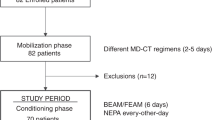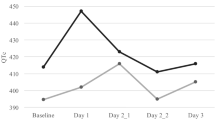Abstract
Nausea and vomiting remain among the most feared side effects of chemotherapy for cancer patients. Significant progress has been made in the last 15 years in developing more effective and better-tolerated measures to minimize chemotherapy-induced nausea and vomiting (CINV). During the 1990s, the selective 5-hydroxytryptamine receptor antagonists were first introduced for the treatment of CINV, and resulted in more effective and better tolerated treatment of CINV. Despite recent progress, however, a significant number of patients still develop CINV, particularly during the 2–5 day period (delayed emesis) following chemotherapy. There is evidence that this may be an underappreciated problem on the part of some caregivers. Recently, two new antiemetics, aprepitant, the first member of the neurokinin-1 antagonists, and palonosetron, a second-generation 5-hydroxytryptamine receptor antagonist, received regulatory approval in the US. Both represent useful additions to the therapeutic armamentarium for the management of CINV.
This is a preview of subscription content, access via your institution
Access options
Subscribe to this journal
Receive 12 print issues and online access
$209.00 per year
only $17.42 per issue
Buy this article
- Purchase on Springer Link
- Instant access to full article PDF
Prices may be subject to local taxes which are calculated during checkout
Similar content being viewed by others
References
Coates A et al. (1983) On the receiving end—patient perception of the side-effects of cancer chemotherapy. Eur J Cancer 19: 203–208
Hesketh PJ (1994) Treatment of chemotherapy-induced emesis in the 1990s: impact of the 5-HT3 receptor antagonists. Support Care Cancer 2: 286–292
Hesketh PJ (2000) Comparative review of 5-HT3 receptor antagonists in the treatment of acute chemotherapy-induced nausea and vomiting. Cancer Invest 18: 163–173
Grunberg SM et al. (2004) Incidence of chemotherapy-induced nausea and emesis after modern antiemetics. Cancer 100: 2261–2268
Tavorath R and Hesketh PJ (1996) Drug treatment of chemotherapy-induced delayed emesis. Drugs 52: 639–648
Eisenberg P et al. (2004) Efficacy, safety and pharmacokinetics of palonosetron in patients receiving highly emetogenic cisplatin-based chemotherapy: a dose-ranging clinical study. Ann Oncol 15: 330–337
Eisenberg P et al. (2003) Improved prevention of moderate emetogenic chemotherapy-induced nausea and vomiting with palonosetron, a pharmacologically novel 5-HT3 receptor antagonist: results of a phase III, single-dose trial versus dolasetron. Cancer 98: 2473–2482
Gralla R et al. (2003) Palonosetron improves prevention of chemotherapy-induced nausea and vomiting following moderately emetogenic chemotherapy: results of a double-blind randomized phase III trial comparing single doses of palonosetron with ondansetron. Ann Oncol 14: 1570–1577
Aapro M et al. (2003) Palonosetron is effective in preventing acute and delayed chemotherapy-induced nausea and vomiting in patients receiving highly emetogenic chemotherapy (HEC) [abstract]. Support Care Cancer 11: a17
Saria A (1999) The tachykinin NK1 receptor in the brain: pharmacology and putative functions. Eur J Pharmacol 375: 51–60
Bountra C et al. (1993) Anti-emetic profile of a non-peptide neurokinin NK1 receptor antagonist, CP-99,994, in ferrets. Eur J Pharmacol 249: R3–R4
Watson JW et al. (1995) The anti-emetic effects of CP-99,994 in the ferret and the dog: role of NK1 receptor. Br J Pharmacol 115: 84–94
Grelot L et al. (1998) Potent inhibition of both the acute and delayed emetic responses to cisplatin in piglets treated with GR205171, a novel highly selective tachykinin NK1 receptor antagonist. Br J Pharmacol 124: 1643–1650
Hesketh PJ (2001) Potential role of the NK1 receptor antagonists in chemotherapy-induced nausea and vomiting. Support Care Cancer 9: 350–354
Hesketh PJ et al. (2003) The oral neurokinin-1 antagonist aprepitant for the prevention of chemotherapy-induced nausea and vomiting: a multinational, randomized, double-blind, placebo-controlled trial in patients receiving high-dose cisplatin—the Aprepitant Protocol 052 Study Group. J Clin Oncol 21: 4112–4119
Poli-Bigelli S et al. (2003) Addition of the neurokinin 1 receptor antagonist aprepitant to standard antiemetic therapy improves control of chemotherapy-induced nausea and vomiting. Results from a randomized, double-blind, placebo-controlled trial in Latin America. Cancer 97: 3090–3098
de Wit R et al. (2004) The oral NK(1) antagonist, aprepitant, given with standard antiemetics provided protection against nausea and vomiting over multiple cycles of cisplatin-based chemotherapy: a combined analysis of two randomised, placebo-controlled phase III clinical trials. Eur J Cancer 40: 403–410
Warr DG et al. Effect of aprepitant for the prevention of nausea and vomiting after one cycle of moderately emetogenic chemotherapy: a randomized double-blind trial in 866 patients [abstract]. J Clin Oncol, in press
Kris MG et al. (2005) Consensus proposals for the prevention of acute and delayed vomiting and nausea following high-emetic-risk chemotherapy. Support Care Cancer 13: 85–96
Author information
Authors and Affiliations
Corresponding author
Ethics declarations
Competing interests
The authors declare no competing financial interests.
Rights and permissions
About this article
Cite this article
Oo, T., Hesketh, P. Drug Insight: new antiemetics in the management of chemotherapy-induced nausea and vomiting. Nat Rev Clin Oncol 2, 196–201 (2005). https://doi.org/10.1038/ncponc0132
Received:
Accepted:
Issue Date:
DOI: https://doi.org/10.1038/ncponc0132
This article is cited by
-
Oliceridine is Associated with Reduced Risk of Vomiting and Need for Rescue Antiemetics Compared to Morphine: Exploratory Analysis from Two Phase 3 Randomized Placebo and Active Controlled Trials
Pain and Therapy (2021)
-
Cost-utility analysis of palonosetron in the antiemetic regimen for cisplatin-containing highly emetogenic chemotherapy in Japan
BMC Health Services Research (2019)
-
Phase II study of palonosetron, aprepitant and dexamethasone to prevent nausea and vomiting induced by multiple-day emetogenic chemotherapy
Supportive Care in Cancer (2017)
-
Efficacy of palonosetron and 1-day dexamethasone in moderately emetogenic chemotherapy compared with fosaprepitant, granisetron, and dexamethasone: a prospective randomized crossover study
International Journal of Clinical Oncology (2015)
-
Palonosetron and dexamethasone for the prevention of nausea and vomiting in patients receiving allogeneic hematopoietic stem cell transplantation
Supportive Care in Cancer (2014)



